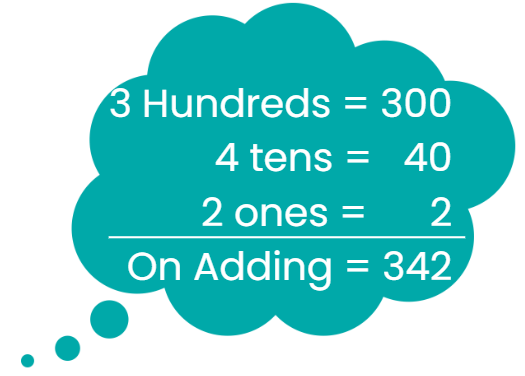Word Problem: Numeration | Mathematics for Class 4 PDF Download
Q1: If you have 3 hundreds, 4 tens, and 2 ones, what number do you have?
Ans: Hundreds: 3 hundred means you have 3 groups of 100. So, .
Tens: 4 tens means you have 4 groups of 10. So, .
Ones: 2 ones means you have just 2.
Now, you add them all together:
So, the number is 342.
Q2: You have 500 marbles. Your friend gives you 150 more marbles. How many marbles do you have now?
Ans: Start with 500 marbles. Your friend gives you 150 more marbles.
To find out how many you have now, you add:
Now, you have 650 marbles.
Q3: Sarah has 7,200 stickers. She gives away 1,500 stickers to her friends. How many stickers does she have left?
Ans: Sarah starts with 7,200 stickers. She gives away 1,500 stickers.
To find out how many stickers she has left, you subtract:
So, Sarah has 5,700 stickers left.
Q4: If the greatest 5-digit number is 99,999, what is the successor of this number?
Ans: The greatest 5-digit number is 99,999. The successor of a number is what you get when you add 1 to it.
So, you do:
Therefore, the successor is 100,000.
Q5: If you add 1 to the number 1,00,000, what number do you get, and how many digits does it have?
Ans: Start with 100,000. When you add 1, you get:
To find out how many digits this number has, count them: 1, 0, 0, 0, 0, 1. That makes 6 digits.
So, the answer is 100,001, which has 6 digits.
Q6: If you write the number 23,344 in expanded notation, what is its expanded form?
Ans: In expanded notation, we break down each digit by its place value:
- 2 is in the ten thousand place:
- 3 is in the thousands place:
- 3 is in the hundreds place:
- 4 is in the tens place:
- 4 is in the ones place:
Putting it all together, you get:
Q7: If you have the numbers 12,675, 6,532, 62,392, 18,125, and 29,358, how would you arrange them in ascending order?
Ans: To arrange these numbers in ascending order (from smallest to largest), you compare each number:
- The smallest number is 6,532.
- Next is 12,675.
- Then comes 18,125.
- After that, we have 29,358.
- Finally, the largest number is 62,392.
So, the order is:
Q8: Sarita wants to round off her weight to the nearest ten. If she currently weighs 42 kg, what would her rounded weight be?
Ans: Sarita weighs 42 kg. To round to the nearest ten, we look at the ones digit, which is 2.
Since 2 is less than 5, we round down.
So, 42 kg rounded to the nearest ten is 40 kg.
Q9: If you have 1 lakh rupees and add ₹1 to it, what is the new amount in numerical form?
Ans: 1 lakh is written as 100,000. When you add ₹1, you do:
So, the new amount is 100,001 rupees.
Q10: What is the difference in place value between the digit 5 in the number 56,789 and the digit 5 in the number 5,678?
Ans: In the number 56,789, the digit 5 is in the thousands place, so its place value is:
In the number 5,678, the digit 5 is in the hundreds place, so its place value is:
Now, to find the difference in place values:
So, the difference in place value is 4,500.
|
33 videos|241 docs|30 tests
|
FAQs on Word Problem: Numeration - Mathematics for Class 4
| 1. What is numeration in mathematics? |  |
| 2. How do we read large numbers in numeration? |  |
| 3. What are the different types of numeration systems? |  |
| 4. Why is place value important in numeration? |  |
| 5. How can I practice numeration skills at home? |  |

















